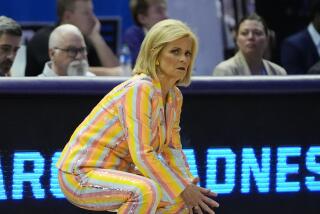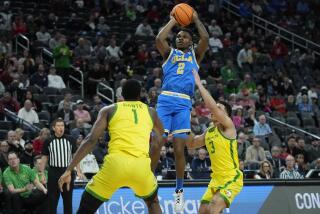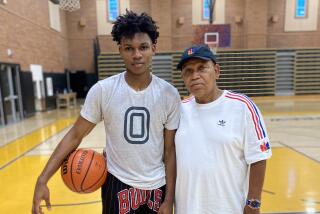Hank Gathers lives on in his house
Twenty years later, grown men still grab Bo Kimble’s hand and cry.
“They won’t let go,” he says.
Twenty years later, Paul Westhead plays the videotape for his Oregon women’s basketball team and they howl.
“They can’t believe what they are seeing,” he says. “Sometimes I can’t either.”
Twenty years later, the mother of the late Hank Gathers can finally smile.
“My son’s memory has become such a strength to so many people,” Lucille Gathers Cheeseboro says.
In an era of sports cynicism and strife, the saddest, sweetest college basketball story still lives.
You can see it in the chills of those who witnessed it and the sad smiles of those who lived it, the sorrow and joy of the 1989-90 Loyola Marymount basketball team.
“It was just one moment in time,” Kimble says. “But that moment has been strong enough to last forever.”
Even now, looking back through the lens of a sports landscape filled with an upset a minute, the moment remains nothing short of a miracle.
Twenty years ago, a raggedy group of playground stars from a tiny Catholic college watched their best player collapse and die of a heart ailment during the first half of a game in the conference tournament on their home court.
Twelve days later, the team began a run through the NCAA tournament that fell only one game short of the Final Four.
On the way, they set records for scoring and symbolism, for three-pointers and tears, a bunch of grieving but gripping kids providing a transfixed nation with lessons of the heart.
In short, it was about a left-handed free throw.
In choosing to honor the fallen Gathers, who had been trying to perfect a left-handed free throw at the time of his death, teammate and best friend Kimble decided to shoot the first free throw of every tournament game left-handed.
This is even though Kimble is right-handed, and even though the Lions were such big underdogs that every point would matter.
Do you remember now? In my 23 years at The Times, I have never seen a more compelling moment on a basketball court.
Four times Kimble threw up the left-handed shot. Four times fans would openly weep. Four times he made the shot.
It was the perfect symbol for a mournful, magical stretch of basketball that will never be repeated.
“Shot left-handed free throws three times in the NBA,” Kimble says. “Missed them all.”
The players from that 1989-90 team returned to Gersten Pavilion -- site of Gathers’ greatest triumphs and his shocking death -- on Saturday night to be honored by the school.
At halftime of the Lions’ eventual 85-67 loss to St. Mary’s, fans roared as everyone from Kimble to Gathers’ mother was given a replica piece of the old gym floor.
Above them, Gathers’ No. 44 still adorns the gym wall. Around them, the students here, some of whom were not even born during the run, still chant Gathers’ name.
The memories are chronicled in a just-released book by Kyle Keiderling titled “Heart of a Lion.” They can also be found, some say, in the late-night sounds of bouncing balls and spraying showers of a Gersten gym still haunted by his presence.
“We all had the same grief,” Westhead says. “We just put it together and played some ball.”
It started, of course, with Gathers, a 6-foot-7, 235-pound inside force who, as a junior in 1988-89, worked Westhead’s breakneck system to lead the nation in scoring (33.0 points per game) and rebounding (14.0).
“The best [college] player I ever coached was Hank Gathers,” Westhead says, smiling. “We know that. We share that. And if we didn’t know it, Hank would have told us.”
In their senior year, Gathers and Kimble led the Lions to a 23-5 regular-season record that included 122.4 points per game and 28 games over 100 points, both still NCAA records.
Gathers had collapsed earlier in the season with what was diagnosed as an abnormal heartbeat, but finished the season strong, even scoring 48 points against Shaquille O’Neal and Louisiana State, leading the Lions into the postseason.
Then on Sunday, March 4, 1990, with 13 minutes 34 seconds left in the first half of the Lions’ second-round West Coast Conference tournament game against Portland, their world changed forever. Shortly after he scored on an ally-oop dunk, Gathers staggered and collapsed and died at age 23 of what was later diagnosed as a heart muscle disorder.
“It was something that changed all of us forever,” teammate Chris Knight says. “To witness the death of our leader affected all of us in ways that we probably still don’t even know.”
But who would have thought it would immediately affect them as it did?
The Portland game and the tournament were canceled, and the Lions were given the NCAA tournament bid on the basis of their regular-season championship, but they were seeded 11th with expectations that they would succumb to their grief.
“The players had just lost their leader, the center of everything on that team,” then-athletic director Brian Quinn says. “Nobody knew what was going to happen.”
A hint was given two days later when, during Gathers’ memorial service at Gersten, Kimble took the microphone and asked the crowd for “one last round of applause for Hank, here in his house.”
The roar lasted two weeks.
Twelve days after Gathers’ death, the Lions drove to Long Beach for a first-round game with favored New Mexico State. Gathers’ memory was everywhere, his No. 44 stenciled on their jerseys, fans holding signs reading “Hank lives” and Westhead writing “the dream is alive” on the locker room blackboard.
“This is for you, Hank,” Kimble said in a taped TV interview that ran before he shot his first free throw left-handed -- and swished it.
New Mexico State never had a chance, falling, 111-92.
Next up, defending champion Michigan, a game for which Westhead prepared his team by giving them each the same individual pep talk.
“Bo, bombs away . . . Jeff [Fryer], bombs away . . . Terrell [Lowery], bombs away.”
So they did, setting 11 -- that’s not a misprint -- NCAA tournament records in a 149-115 victory over the Wolverines.
“It’s hard to put into words how much it changed all of us so quickly,” Lowery says. “It was a tragedy that became, in some ways, a blessing.”
Next up, a trip to Oakland, where the Lions’ regional semifinal game against Alabama was CBS’ centerpiece national game.
The Crimson Tide tried to slow the Lions, frustrating them so much that at one point, Kimble lost his cool and was assessed a technical foul. Knight quickly walked over to Kimble, grabbed his jersey, and pointed to the 44 stitching.
Message delivered. The Lions settled down enough to win the kind of deliberate game that folks thought they could never win -- 62-60 -- with an ending that confirmed there were other forces at work.
Guess who missed a long jumper for Alabama at the buzzer. Big Shot Robert Horry, that’s who.
Only one victory from the Final Four, the Lions faced Nevada Las Vegas, a talented team that would eventually win the national championship.
By then, Kimble was on the cover of Sports Illustrated, the Loyola Marymount bookstore was swamped with memorabilia orders and the regional final ticket was the hottest in the country. Even Las Vegas was caught up in the emotion, its players actually wearing black armbands in honor of their opponent.
“It was this big in the era before everyone used the Internet, before sports was so big everywhere,” Lowery says. “Can you imagine how big it would be today?”
It was there the magic ended. The players were eventually too overmatched and too drained to do anything about it.
The score was Las Vegas 131, Loyola Marymount 101, the Rebels running away with the dream.
But not really. The players on that Lions team keep it alive even today, with Kimble running a “44 For Life” foundation and Lowery working in foster care and others find themselves in service to the community.
“This is something that will stay with us for a lifetime,” Westhead says.
After their halftime ceremony Saturday, the former players put their hands together for another cheer, while in the stands, their team trailing by 15 points but hope never lost, the fans kept chanting, now and forever.
“This is Hank’s House! This is Hank’s House!”
More to Read
Go beyond the scoreboard
Get the latest on L.A.'s teams in the daily Sports Report newsletter.
You may occasionally receive promotional content from the Los Angeles Times.











